AI-Powered Travel Planning: My Experience Letting an AI Plan My Trip
In the age of artificial intelligence, it was only a matter of time before travel planning became one of the many tasks AI could tackle. With algorithms capable of digesting vast amounts of data and turning it into personalized recommendations, I decided to put AI to the test and let it plan an entire trip for me. The result? A fascinating, sometimes surprising, but ultimately rewarding travel experience that has completely changed the way I think about planning vacations.
Here’s a detailed look at my AI-powered travel journey—from concept to conclusion.
The Inspiration Behind an AI-Powered Trip
Like many others, I’ve spent countless hours in the past bouncing between travel blogs, review websites, booking platforms, and social media while trying to plan the “perfect” trip. It’s exhausting. The idea of offloading that mental load to an intelligent assistant intrigued me. With AI becoming more accessible—thanks to platforms like ChatGPT, Google Bard, and travel-specific tools like Roam Around and Trip Planner AI—I figured it was time to hand over the reins.
My goal? To go on a 5-day vacation that would be enjoyable, efficient, and ideally, stress-free—without doing any traditional research myself.
Choosing the Right AI Tools
To start, I explored several AI-based travel planners. Some of the tools I tested included:
• Roam Around – An AI trip planner that integrates GPT technology to offer customizable itineraries.
• Trip Planner AI – Known for its user-friendly interface and flexible suggestions.
• ChatGPT – My go-to assistant for general questions and deeper customization.
• Google Maps & Bard – For verification of routes, distances, and quick access to real-time data.
I eventually settled on a combination of ChatGPT and Roam Around to craft my itinerary. Roam Around generated the daily schedules, while ChatGPT helped refine details like transportation options, hotel neighborhoods, and food preferences.
Setting the Parameters
To give the AI some direction, I input the following details:
• Destination: Lisbon, Portugal
• Duration: 5 Days
• Interests: Local culture, food, scenic spots, some light hiking, and art
• Budget: Mid-range (neither backpacking nor luxury)
I didn’t suggest specific places or hotels—I wanted the AI to be in full control.
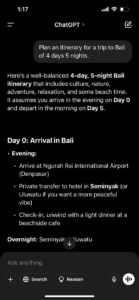
The Itinerary: A Day-by-Day Breakdown
Here’s what the AI came up with:
Day 1: Arrival and Introduction to Lisbon
• Arrive at Lisbon Portela Airport
• AI-recommended hotel: Lisboa Carmo Hotel, centrally located
• Afternoon: Leisurely walk through Baixa and Chiado neighborhoods
• Evening: Dinner at Time Out Market
Thoughts: A solid start. The hotel was indeed well-rated and centrally located, which made walking around easy. Time Out Market was vibrant and had tons of food options that fit every budget.
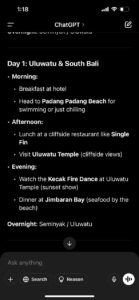
Day 2: Culture and History
• Morning: Explore Belém Tower and Jerónimos Monastery
• Lunch: Sample pastéis de nata at Pastéis de Belém
• Afternoon: Visit the MAAT museum
• Evening: Fado dinner in Alfama
Thoughts: AI nailed this one. The day flowed smoothly, with plenty of time between activities. The Fado dinner was an unexpected highlight, giving me a beautiful cultural experience.
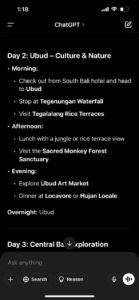
Day 3: Day Trip to Sintra
• Early train to Sintra
• Visit Pena Palace, Moorish Castle, and Quinta da Regaleira
• Lunch at a local café
• Return to Lisbon in the evening
Thoughts: This was an ambitious day, but very well planned. AI provided a great route to minimize backtracking. Sintra was stunning, and I probably wouldn’t have made the day trip without the AI suggesting it.
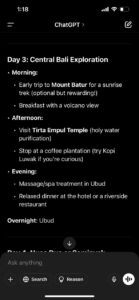
Day 4: Art, Parks, and Hidden Gems
• Morning: Visit the Calouste Gulbenkian Museum
• Afternoon: Stroll through Eduardo VII Park
• Coffee at LX Factory
• Evening: Street art tour in Marvila
Thoughts: I loved this day because it focused on the lesser-known, more “local” aspects of the city. The street art tour in Marvila was a pleasant surprise, and I never would’ve thought to go there on my own.
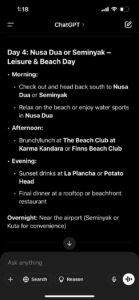
Day 5: Last-Minute Exploration and Departure
• Morning: Shopping and souvenirs in Príncipe Real
• Brunch at The Mill
• Taxi to the airport in the afternoon
Thoughts: A chill wrap-up. It gave me time to reflect and pick up a few things to take home.
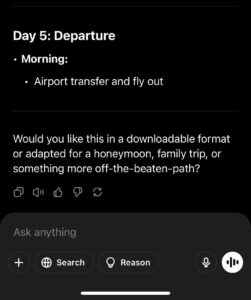
Pros of Letting AI Plan the Trip
1. Time-Saving
I didn’t spend hours comparing TripAdvisor reviews or scrolling endlessly through Instagram. The AI did the heavy lifting and gave me a ready-made itinerary.
2. Customization
Once I gave it some basic preferences, the AI delivered a plan that felt very me. It wasn’t too touristy but still hit all the major sights.
3. Balanced Planning
Each day had a great balance of activity and downtime. There were no overpacked schedules or long commutes.
4. Discovery of Hidden Gems
I probably never would have discovered places like LX Factory or Marvila’s street art scene without the AI’s suggestions.
What Could Be Improved
1. Restaurant Choices Were Hit or Miss
While most food recommendations were solid, a couple of AI-suggested restaurants were either too touristy or closed on the day I visited. Real-time data integration would help here.
2. Over-Optimistic Time Estimates
AI sometimes underestimated how long certain activities would take, especially when factoring in lines, walking time, or public transportation delays.
3. Lack of Personal Touch
AI doesn’t account for personal energy levels, moods, or spontaneous desires. Human flexibility is still essential for a good travel experience.
Tips for Letting AI Plan Your Trip
• Double-check the suggestions on Google Maps or Yelp to ensure accuracy.
• Leave room for spontaneity. AI can give you a framework, but don’t feel locked in.
• Specify your preferences clearly at the beginning—AI gets better the more information you provide.
• Use multiple tools. No single AI tool is perfect, but combining them gives you better results.
Final Thoughts
Letting AI plan my trip was a surprisingly pleasant experiment. It offered a thoughtful, well-rounded itinerary that took much of the stress out of the planning process. While there’s still no substitute for local knowledge and human intuition, AI has come a long way in making travel more accessible, personalized, and efficient.
Would I do it again? Absolutely. AI won’t replace traditional travel agencies or personal research entirely just yet, but it’s definitely a powerful co-pilot for modern travelers.
So if you’re planning a trip soon and want to save time while discovering new things, try letting AI take the wheel—you might just be surprised where it takes you.
Have you tried using AI to plan a trip? Share your thoughts and experiences in the comments below!
